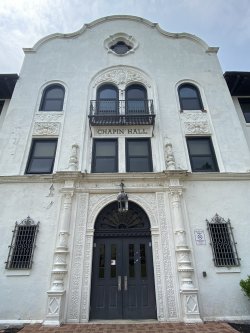Dr. Teresa Fiore Mentors Student Mar Arroyo Cabrera as Part of Undergrad Research Program
Posted in: CHSS News, Endowed Chair's Research, Inserra Chair News and Announcements, Italian News and Events

The project titled “The Colonial Revival Architectural Style from Spain to Montclair State University: Imperial Routes and Transnational Affinities,” designed by Dr. Teresa Fiore (Inserra Chair in Italian and Italian American Studies, WLC Dept.) was successfully selected for the 2023 Undergraduate Research Program. As part of it, Dr. Fiore is mentoring Mar Arroyo Cabrera (a student from the Dominican Republic, majoring in Communication and Media Studies, and minoring in French), as she researches the history of the Montclair State University campus’ architecture. The project also involves the participation of Isaak J. Liptzin from Awen Film Production, a company based in New York, whose role is that of assisting in creating the final product, a short documentary (now available on the Inserra YouTube channel)

Starting in 1908, the campus was built according to the Spanish Colonial Revival Style, which early donor Mr. Russ chose after falling in love with it during a visit to California (see article). Example of this initial phase are College (now Cole) Hall, Russ Hall, Chapin Hall, and Morehead Hall, characterized by white facades, red-tile roofs, ornate decorations around the frames of the entry doors, bell towers, etc.
After an interruption of a few decades, in the 1990s, the style was picked up again in University Hall, in what we could call the revival of the revival, and has stayed since then in the new buildings or the renovation of the existing ones, such as Cole Hall, albeit in increasingly simplified forms over time.
This project looks at the Spanish Colonial Revival architecture, a late 1800s-early 1900s revisitation and expansion on the Spanish Mission style of the early Spanish imperial period in the U.S. Southwest (1700), as a way to explore transnational connections across such diverse spaces as Spain, the Mediterranean at large including Italy, the U.S. Southwest and…. the Montclair State University campus. An obvious question for a first-time visitor at MSU is: What does the Spanish Colonial Revival architectural style have to do with a New Jersey campus? The project aims at researching the history of the architecture of the Montclair State University campus, while inserting it in the broader history of the circulation of colonial baroque in the Spanish Empire. The irony embedded in the original choice of style lies in the fact that today Montclair State University is a Higher Ed institution with a large and growing percentage of Hispanic students. What kind of opportunities does this coincidence open up in the understanding of forms of transnational relocation and belonging?
The project’s methodology includes research at the Montclair State University library for materials about the campus history; and at the Avery Architectural Library, Columbia University for the sources focusing on the Spanish Mission and Spanish Colonial Revival Styles.

The project involves interviews with architects such as Frank Gerard Godlewski; and a collaboration with Isaak J. Liptzin of Awen on the filming of the interviews and the campus buildings as well as the editing and overall production of the final short.

The project is part of a larger endeavor launched in 2021, called Memoria Presente, created in part in response to Montclair State University’s federal designation as Hispanic Serving Institution in 2016. Memoria Presente: The Common Spanish Legacy in Italian and Latin American Cultures is an open-access digital archive that hosts a set of interdisciplinary materials highlighting these connections in literature, food, film, and botany. A future section will be devoted to Art and Architecture and the final video of the Undergraduate Research Program project will be available there.
Short link: http://tinyurl.com/MSUArchitecture
Photo credit for the images of buildings: Mar Arroyo Cabrera





